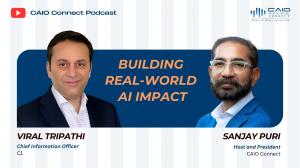Viral Tripathi on Building Real-World AI Impact at C1 — Featured on The CAIO Connect Podcast with Sanjay Puri
Viral Tripathi joins Sanjay Puri on The CAIO Connect Podcast to reveal how CAIOs drive real AI value through strategy, fast learning, and strong governance.
Don't wait to fail till the end; fail small, learn, create that loop, and whatever works... you need to have that clarity and confidence to aggressively go and put it out in the market.”
WASHINGTON, DC, UNITED STATES, November 20, 2025 /EINPresswire.com/ -- Viral Tripathi on Building Real-World AI Impact at C1 — Featured on The CAIO Connect Podcast with Sanjay Puri— Viral Tripathi
Artificial intelligence is no longer a futuristic promise—it is actively transforming how businesses operate today. Yet, as AI enthusiasm surges, many leaders still struggle to convert ambition into tangible and defensible ROI.
In a recent episode of The CAIO Connect Podcast, host Sanjay Puri sat down with Viral Tripathi, CIO of C1, to unpack what it truly takes to build an AI-first organization. With years of experience guiding enterprise transformation, Tripathi delivers a pragmatic, hype-free blueprint for turning AI into measurable business impact.
Their conversation centers around three major themes:
1. the rise of the CAIO as a strategic business function,
2. how to quantify AI value beyond traditional ROI models, and
3. the increasing urgency of governance as agentic AI enters the workforce.
The Evolving CAIO Role: Strategy Over IT
A. AI Is Everyone’s Job
Tripathi emphasizes that AI is no longer confined to technical teams. Instead, it must influence every function and workflow. The modern CAIO’s mandate is to raise organizational capability, reshape processes, and drive productivity across the enterprise.
B. Outcomes Over Buzzwords
Tripathi describes AI as a “toolkit,” not a trophy. Leaders must ask whether a use case enhances customer experience, removes friction, or accelerates operations. Pursuing AI because it feels novel is not strategy; pursuing it to achieve specific outcomes is.
C. Reporting to the CEO
Because the CAIO role is fundamentally transformative, Tripathi notes that it should report to the CEO or operate alongside top technology leadership. Like the CIO role decades ago, the CAIO must have enterprise-wide visibility and influence.
Strategic Leadership: Humility and Confidence
A. Bridging Technical and Business Worlds
Tripathi stresses that the CAIO must act as a translator—helping data teams understand business goals and enabling business leaders to see what is technically achievable. Effective AI leadership means aligning everyone to the value chain.
B. Failing Small, Learning Fast
He advocates for small, low-risk pilot projects. Tripathi believes innovation is rooted in humility: leaders must iterate quickly, learn from early experiments, and scale aggressively once success is validated.
C. Managing Change and Anxiety
AI introduces uncertainty, capability gaps, and job transitions. Tripathi argues that leaders must guide teams through this anxiety by reimagining workflows and diagnosing failure thoughtfully—clarifying whether missteps arise from technology, approach, or business fit.
Quantifying AI Value: Beyond the PowerPoint ROI
A. ROI as Organizational Evolution
Tripathi compares today’s AI landscape to the early cloud era: its biggest value may lie in enabling business models that do not yet exist.
B. Augmentation, Not Replacement
For now, AI enhances human capability. Tripathi uses examples such as lawyers reviewing contracts faster so they can focus on the most important ones—a qualitative gain with significant strategic value.
C. Guidance for CFOs and Boards
He encourages leaders to start small, validate results quickly, and pivot when value isn’t clear. Pragmatism must guide AI portfolios.
Governance: Preparing for the Digital Workforce
Tripathi explains that agentic AI—systems performing multi-step workflows autonomously—signals the rise of a digital workforce. This shift introduces new accountability, HR, and performance-management challenges as humans and bots work side by side.
Because machine error is less tolerated than human error, governance must be rigorous and cross-functional. Synthetic data, in particular, brings both huge promise and hidden ethical risks.
Summarizing
As highlighted by Sanjay Puri on The CAIO Connect Podcast, Viral Tripathi’s perspective underscores that real AI impact requires outcome-driven strategy, humility in experimentation, and strong governance. The organizations willing to evolve responsibly will define the decade ahead.
Upasana Das
Knowledge Networks
email us here
Visit us on social media:
LinkedIn
Instagram
Facebook
YouTube
X
Legal Disclaimer:
EIN Presswire provides this news content "as is" without warranty of any kind. We do not accept any responsibility or liability for the accuracy, content, images, videos, licenses, completeness, legality, or reliability of the information contained in this article. If you have any complaints or copyright issues related to this article, kindly contact the author above.


